

|
Home Updates Hydros Cars Engines Contacts Links Contact On The Wire Next→ |
George Noble
|
|
The 'hardy veteran' Amongst the early pioneers of tethered hydroplane racing, there were none more enthusiastic or prolific in the number of boats that they built and competed with than the Noble brothers of Bristol. Therefore, when The Bristol Society of Model Engineers celebrated their Centenary in 2009 by publishing an excellent history of the club, it was an ideal opportunity to find out more about both the Society and the Noble brothers. Written by Geoffrey Shepherd, the publication covers the wide range of interests undertaken by the Club over the years. The Model Powerboat section includes the story of tethered hydroplanes in Bristol and George Noble who played such a prominent part in the Bristol Society. George Noble, or G. D. Noble of Bristol as he was usually referred to in the Model Engineer, started competing in 1909 and apart from a short break because of illness was still featuring in the results forty-six years later, yet remains something of an enigma.
|
|
Although identified with Bristol, George was not a Bristolian. The story starts, not in that city, but in London. George Davidson Noble was born at the end of 1881 to James S Noble a carpenter, and his wife Susannah, both Londoners. He was the third child, with two older sisters; Mary Ann, aged 8 and Ada 3. The family was living at 90 Globe Rd, Mile End Old Town, within a mile of 'Bow Bells' and so, by definition, a cockney lad. A couple of years after George was born the family moved to 107 East Street, Hereford. Four more children were born, Bertie, Susannah, Alice and Samuel the last in 1888. Right: James and Susannah Noble |
|
George was 12 years old when his mother Susannah died in 1893. George’s father married Sarah Thomas, a lady from Wales, in September 1900. They lived at 224 Portland St., Hereford with Sarah’s daughter Maud aged 13, and James’ son Samuel then 12. George at 19 was working as a grocer’s assistant and boarding with Emma and Henry Boutcher and their four children in Ledbury, 12 miles to the east of Hereford.
|
|
|
By 1911 James and Sarah had moved to 1 Douglas Rd, Horfield, a district of Bristol. With them were George, still working as a shop assistant, and his brother Samuel who had followed his father and become a carpenter. George far left, Samuel left. What started George’s interest in model engineering is not known, but he claimed that in 1909 he started to take an active interest in flash steam plants. Eastville Park Lake, just down the road from Horfield, was by coincidence opened that year as well, and would play an important part in George’s racing life. |
|
The Model Engineer of June 1st 1911 carried the first of many letters George wrote to them over the years, saying ‘that he and his brother (Samuel) will be running a 2ft model hydroplane on the lake at Eastville Park on Whit Monday morning. They will be pleased on that occasion to see any fellow readers interested in model speed craft particularly if they bring their boats with them. ’The first racing achievement for the brothers came at a regatta early in 1911 when they won the MYRA metre Challenge Cup with Noble Minor at a speed of 4mph. The engine from this boat was later transferred to another hull and became Tiddly II. Noble Major, a Class B boat, also made its first appearance in the 1911 regatta. |
|
Unfortunately it would not start and was described as an unlucky boat. The plant was then fitted in a Class D hull and became ‘Limpet’ The highest recorded speed for Limpet was 9 mph ‘on a semi-circular course. Folly was doing 16mph.’ (Herbert Teague and Vernon Delves Broughton’s flash steamer.)
In 1912, after two or three years of trying, George and Samuel managed to complete the necessary number of runs to enter the annual Model Engineer Speed Boat Competition. Running a tinplate, single step, steam powered hydroplane, 33 inches long by 10 inch beam, named Owler, they entered it in Class D for boats weighing under 10lbs. George wrote ‘that the three runs of 110yds each were made with the boat, tethered to a line, attached to a pole pushed in the ground close to pond bank in such a position that a line starting point to finish intersected the pole, thus giving a run of half a circle. The line length was 36yds.1ft and the height of the pole was 4ft 6inches.
| Owler achieved a run of 15.88mph and a silver medal. They also entered
C Class for boats up to 20lb, another steam, single step hydro named Defender.
One metre long with a 7"7/8th beam with a hollow V bottom, it reached
a speed of 11.77mph. winning the brothers a bronze medal. Stopping the boats
travelling at this speed on a semi-circular course must have been something of
an adventure? By 1913 George had become honorary secretary to the Bristol Society of Model Engineers and Craftsmen. He felt that the hydroplane racing was not going well and he had decided to take some time out. Right: The Noble's 'Three fine racers' Defender, Owler and Tiddly |
|
|
|
Herbert Teague was the man responsible for the name that Noble’s boats carried from 1913 onwards and came about, as Noble writing to the Model Engineer explained. ‘Met these gentlemen, Teague and Groves at the ME exhibition, along with Mr Delves Broughton. To Mr Teague, though perhaps unwittingly, Bulrush owes her name. |
It happened like this. We had been talking of the sport in general and the ‘dark horses’ who had scratched at the last moment in particular, and when we parted, he said to me, "Don’t be a broken reed, be a bulrush!" and I decided that a bulrush I would be.’ Following his talk with Herbert Teague, George felt more enthusiastic, and the first of a long line of boats started to be built.
Bulrush had its first outing on Nov 16th 1913. In the December, a letter to the ME read as follows: -
‘We had recently taken Bulrush out for a demonstration run, and owing to rowing boats being out, we were unable to run on the circular course and had to run from the bank on the semicircular course. While my attention was taken up in bringing the engine up to speed, I failed to notice that a canoeist had got in the way, and only noticed it when I released the boat, with the result that she struck the canoe with a glancing blow sufficiently hard to stove a hole large enough to make the canoeist put on full speed for the bank to avoid foundering.
|
This collision put her off her course and she came into the side out of my brother’s reach. Fortunately (?) the lamp got displaced in the collision, so that she had quieted down somewhat before hitting the bank, or we should have had very little hull left. As it was, the plant was wrenched bodily out of the hull and piled up. Barring the bending of the connecting pipes, etc., the plant was undamaged and everything is in running order again. This accident has forcibly impressed us with the necessity of the circular course for really high-speed craft.’ Right: Bulrush after the collision |
|
|
|
There was a postscript to this accident with George writing, ‘We were anticipating a bill for repairs to the canoe as a consequence. The same weekend, fortunately for us, the boathouse came in for the attentions of the local suffragettes, both house and boats being burned.’ Bulrush was entered in Class C in the ME Speed Boat Competition that year, winning a silver medal, at a speed of 22.77mph, which also gave the Noble brothers the outright speed record. Limpet also had a new engine and when they got it running successfully decided, as George put it, ‘to go pot hunting’. Left: Bulrush Motor |
They entered the August Bank holiday meeting at Portsmouth, but first of all had to get there from Bristol. The Bristol Club was not attending and there was no direct train service, so they caught the train to London, but missed the connection from Paddington to Victoria. Two hours later they caught the train to Portsmouth arriving an hour after the start of the meeting. Luck was not on their side as first the boat capsized and was recovered minus the lamp. The next run saw the cotter in the pump crank break and finally, the steam end of the coil split. George said they left Portsmouth,’ sadder but not much wiser men, and minus the finest blowlamp we have ever had before or since.’ Limpet seemed to have inherited the unlucky streak from Owler. The brothers also continued to run Savage and Tiddly II along with Bulrush up to 1915 when organised racing was stopped because of World War One.
Samuel had married Alice M O’Brien in 1914, having a son, Reginald in the same year. George married Grace Lilian Tippett in 1917 and they had a daughter Barbara in 1918, both families continued to live in Bristol. Somewhere around 1921, George started working at the Government Training School, in Radnor Rd, Horfield, and there he stayed for 25 years. When he retired he was their chief engineering instructor.
It was not until 1922, when George featured in the ME Speed Competition, that anything further was recorded about the Nobles in relation to boating. By this time Samuel seems to have ended his involvement, as there is no further mention of him in any publications. Bulrush III, a steam hydroplane was entered in Class C, for boats with a displacement of over 10lbs but not exceeding 20lbs. A speed of 32.56mph won George a Silver Medal, as well as regaining him the outright speed record held by Fred Westmoreland since 1915.
At the 1922 ME Exhibition George exhibited a horizontal twin engine designed for a metre long, twin-screw hydroplane intended to be used for club purposes. However, trials showed it to have design faults, and in an article in 1924 in the ME he laid out his problems and wrote ‘criticisms will be welcomed on this point.
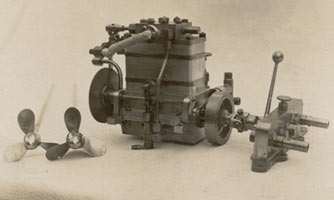 |
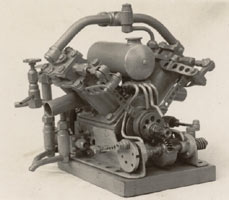 |
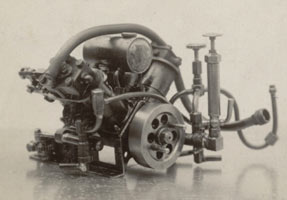 |
| 1¼" bore x 1" stroke twin with gearbox | V4 slide valve flash steam motor | ¾" x ¾" high speed motor for model hydro |
George voiced his concerns to the ME about the proposed amendments to the Speed Competition yet found that nobody else had responded. The editor wrote that ‘Mr Noble asked if there was no longer sufficient interest in this branch (speed) of model power boating. Or have the high-speeds attained by recent medal winners discouraged the majority of would-be competitors? He went on to suggest that perhaps a test of reliability, if rules could be framed, might tempt more people to compete.’
George was also instrumental in setting up the Bristol Model Power Boat Club in 1922. He resigned as honorary secretary of the Bristol Society of Model Engineers and Craftsmen to allow himself time to get the new club off the ground. At the Bristol Society’s ‘Ladies Night’ George was presented with a ‘graceful tribute’, a set of trammels and a purse of money in recognition of the valuable work he had carried out for the society during his years in office. The engine from Bulrush III was displayed along with various other models. The Society and the Boat Club, although separate, shared members and continued to have a close affiliation with each other.
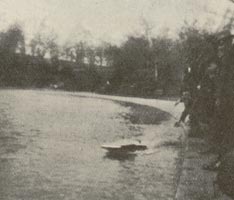 |
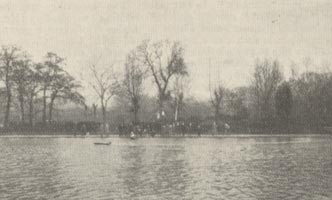 |
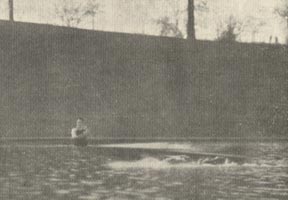 |
| Record breaking flash steam Bulrush III in action at Eastville Park Lake. Taken at the Easter Monday Regatta in 1923 | ||
In the 1923 ME Speed Competition, George, competed under the new rules, which saw Bulrush III, now classified as a Class A boat, having a displacement of over 14lbs and up to 16lbs. He again won a Silver Medal but with a slower speed of 28.2mph.
The late 1920s saw a significant change in the power plants being used in hydroplanes and when Bulrush IV appeared after a gap of nine years, it was not as a flash steamer but with a petrol engine. Apparently, a Mr Tomkinson from Manchester, later of the Altrincham Club, had called to see George and showed him an ohv cylinder head complete with valves, which fired his enthusiasm. George put together a design for a 30cc ohv IC engine and wrote to the ME asking for help as he wrestled, as he put it, ‘with the idiosyncrasies.’ They being that the carburettor flooded due to vibration at speeds over 6,000rpm. He complained as well about ‘petrol and paraffin being nasty stuff to handle’.
The problems must have been partially solved as he appeared for the International Regatta at Victoria in 1932, earning the comment from ‘Spectator, (Lionel French). ‘A bright spot for older enthusiasts, was the appearance of a new ‘Bulrush,’ the work of Mr Noble, one time record holder, his performance was very good for a first effort at a petrol hydroplane. Mr Noble will be well known to older readers of the ME as a pre-war designer of flash steam hydroplanes, notably the famous dynasty of Bulrushes. He had dropped out of the limelight until he decided to stage a comeback, and did so to such good effect as to make one doubt the soundness of the old proverb ‘You can’t teach an old dog new tricks.’ Bulrush IV featured in the 1932 Model Engineer Speed Boat Competition, winning a bronze medal, which George said, gave him as much pleasure as the first one in 1912.
The 1932 Competition also featured another boat built by Noble, but this time it was entered by Bob Kerswell who had built the motor. He had become interested in tethered hydroplanes but needed information so had contacted Noble from an address in Model Engineer. Kerswell acknowledged all the help that Noble had given him in achieving his 2nd place in the A Class. Bob Kerswell would become another long standing member of the Bristol Club.
|
Obviously encouraged, a new hull was built the following year, and so became Bulrush V, wider and shallower, with the aim of going for a world record. One assumes that this was not successful as it was quickly followed by Bulrush VI, which had a pointed bow and a rather wide beam, with shallow freeboard. Right: Bulrush VI |
|
|
|
The ME commented after the 1933 ME Speed Boat Competition in which Bulrush VI came second with a speed of 31.892mph. ‘It has done a very considerable amount of running since being launched, early last year (1933), making a total of 337 laps, the longest non-stop run being 36 laps, which were completed in 4 mins 53 secs. Mr Noble has had some rather bad luck in competition work lately, but his perseverance has gained him a well-merited place in the present competition at any rate. The engine of Bulrush VI embodies some interesting features, including a self-contained plunger oil pump, which, we understand has effectively disposed of all lubrication troubles. A vertical carburettor, float feed, has been found most efficient, and a non-trembler coil and accumulator is employed for ignition.’ Left: George starting Bulrush VI at Farnborough |
There was a follow up to the Speed Competition as Betty, run by the Innocent brothers, who had been declared the fastest boat, was disqualified over a technical offence and Bulrush was awarded the Silver Medal. George wrote to the ME, ‘While it is gratifying to learn that Bulrush VI has gained a ‘Silver’ I am very sorry that it was at the expense of Betty, a better boat, and better handled, than Bulrush VI will ever be. Please do not imagine from this that I despair of catching her-I don’t; but it won’t be with Bulrush VI. After all, Betty is only guilty of a technical offence, and one, I trust, that will not disqualify her from being awarded the ‘Windermere trophy’ as the fastest boat of the year. (Betty was awarded the trophy) It may be of interest to mention that the run forming Bulrush’s entry was made on July 9th. This, you will notice, was the week after the International. Nothing was done to the boat during the interval, yet we were miles per hour faster than at Victoria Park. It must be that Bulrush likes the flavour of her home water best, or, alternatively, dislikes being shaken up by a land vehicle.’
1934 saw Bulrush VII launched at the Grand Regatta, held at Brockwell Park, as Victoria was out of action. Unfortunately, the boat capsized shortly after launching. The tethering pole was said to be the culprit as it was far too flexible and the boat had suffered ‘pole whip’.
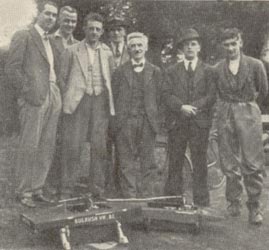 |
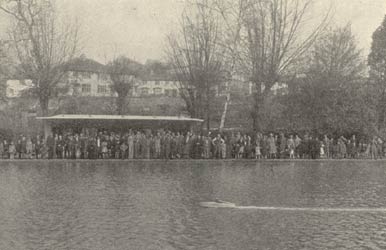 |
| 1934 L-R Rennell,
Brown-Cole, Kerswell, Humphreys, Noble, Dixon and Halliday |
Racing at Eastville Park, Bristol in 1938 |
Lionel French, who used the non-de-plume ‘Spectator’ in the ME while writing about powerboat matters visited the Bristol Club, and under the title, ‘Power Boating at Bristol’ wrote an amusing article. ‘The lake at Eastville Park, Bristol, a few minutes walk from the road is situated in very pleasant surroundings, being surrounded by turf covered slopes on which trees and bushes are dotted; there is a large tree-covered island at one end of the lake. Unfortunately, there is a sinister undertone, this being a very soft clay bottom to the lake, situated about 4 feet below the surface; wading therefore, has its excitements. Ordinary leg waders are, of course, useless, the breast-high fisherman’s type needed. The club have to cease running at 10.30am, a time when many London members have just opened one eye and asked the wife if she is going to get up and make a cup of tea!
|
There was some good running by the boats there and particularly by Mr Noble’s Bulrush VII. After seeing a few runs by this boat, Mr Noble has all my sympathy for the perfectly wretched luck, which has dogged him in regattas in the last two years. On one run he did lap after lap at well under 6 secs, and I am very glad to be able to say that Bulrush VII must be amongst the six fastest boats in the country. It is uncanny the way bad luck can dog a man race after race, not only in model power boats, but in car and motorcycle racing, one often finds an individual who has a name for atrocious luck; frequently, this misfortune ends quite suddenly, and is succeeded by a spell of success. I fervently hope this will be so in Mr Noble’s case; a win for him is long overdue.’ Unbelievably, the same situation as in the 1933 ME Speed Boat Competition was repeated in 1934. Betty was again disqualified, although at 38mph she had been the fastest boat in A Class. Right and below Bulrush VII |
|
|
|
Due to using a line under the required length, this meant that the timing distance was slightly less than the 600yds specified in the rules. Bulrush VII with a speed of 37.934mph therefore won A Class. George also entered B Class with a lighter hulled Bulrush VI and gained a 3rd, with a speed of 31.745mph. This elicited a letter to the ME from George saying, ‘ It was very pleasing to read in this week’s ME of the success of Bulrush VII in last years speed competition. It was entirely unexpected in as much as I was present at Farnborough when Betty did six laps in 32secs- a marvellous run-and to find out the line was short must have been somewhat of a tragedy for her builders. |
In Bristol we have the correct line length marked on the asphalted path by two metal studs, thus providing a convenient test when desired. It is curious that in 1934 as in 1933 Bulrush gets ‘silver’ through the disqualification of another boat. I am still hoping to get a clear-cut win.’
©copyrightOTW2012